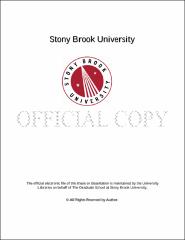| dc.identifier.uri | http://hdl.handle.net/1951/60217 | |
| dc.identifier.uri | http://hdl.handle.net/11401/71052 | |
| dc.description.sponsorship | This work is sponsored by the Stony Brook University Graduate School in compliance with the requirements for completion of degree. | en_US |
| dc.format | Monograph | |
| dc.format.medium | Electronic Resource | en_US |
| dc.language.iso | en_US | |
| dc.publisher | The Graduate School, Stony Brook University: Stony Brook, NY. | |
| dc.type | Thesis | |
| dcterms.abstract | The purpose of this study was twofold: firstly, to investigate the functional differences between the short and long isoforms of human Sts-2, and secondly to identify functional consequences of specific mutations within the human T cell signaling protein Sts-2 (hSts-2). The mutations are associated with generalized vitiligo, an autoimmune disease affecting 0.5-2% population. Sts-2 exists in two forms, a short form containing 623 amino acids and a longer splice variant form containing 661 amino acids. Because two forms of hSts-2 exist, the effect of mutations in both forms was investigated. Short form hSts-2 was found to express at much higher levels than long form hSts-2. However, the mutations were found to have no effect on expression levels in 293T cells. Phosphatase assays were performed to investigate the effects of mutations on phosphatase activity. While both wild-type hSts-2 isoforms have lower phosphatase activity toward the artificial substrate OMFP than mouse Sts-2 in vitro, no obvious differences in the phosphatase activity of the different mutants was evident. To investigate the effects of the mutations on TCR signaling pathways, an NFAT luciferase reporter gene system was used. The luciferase assay results suggest that long form and short form hSts2 may play different roles in TCR signaling. Specifically, over-expressing long form hSts-2 results in down-regulation of the NFAT signal and over-expressing short form results in up-regulation of NFAT activation levels. However, no obvious differences were observed among long form and short form mutants, but results are inconclusive and the function of hSts-2 vitiligo-associated mutants needs to be further investigated. | |
| dcterms.available | 2013-05-24T16:38:14Z | |
| dcterms.available | 2015-04-24T14:45:43Z | |
| dcterms.contributor | Carpino, Nicholas, Krug, Laurie | en_US |
| dcterms.creator | Ling, Liucong | |
| dcterms.dateAccepted | 2013-05-24T16:38:14Z | |
| dcterms.dateAccepted | 2015-04-24T14:45:43Z | |
| dcterms.dateSubmitted | 2013-05-24T16:38:14Z | |
| dcterms.dateSubmitted | 2015-04-24T14:45:43Z | |
| dcterms.description | Department of Biochemistry and Cell Biology | en_US |
| dcterms.extent | 42 pg. | en_US |
| dcterms.format | Monograph | |
| dcterms.format | Application/PDF | en_US |
| dcterms.identifier | http://hdl.handle.net/1951/60217 | |
| dcterms.identifier | http://hdl.handle.net/11401/71052 | |
| dcterms.issued | 2012-12-01 | |
| dcterms.language | en_US | |
| dcterms.provenance | Made available in DSpace on 2013-05-24T16:38:14Z (GMT). No. of bitstreams: 1
StonyBrookUniversityETDPageEmbargo_20130517082608_116839.pdf: 41286 bytes, checksum: 425a156df10bbe213bfdf4d175026e82 (MD5)
Previous issue date: 1 | en |
| dcterms.provenance | Made available in DSpace on 2015-04-24T14:45:43Z (GMT). No. of bitstreams: 3
StonyBrookUniversityETDPageEmbargo_20130517082608_116839.pdf.jpg: 1934 bytes, checksum: c116f0e1e7be19420106a88253e31f2e (MD5)
StonyBrookUniversityETDPageEmbargo_20130517082608_116839.pdf.txt: 336 bytes, checksum: 84c0f8f99f2b4ae66b3cc3ade09ad2e9 (MD5)
StonyBrookUniversityETDPageEmbargo_20130517082608_116839.pdf: 41286 bytes, checksum: 425a156df10bbe213bfdf4d175026e82 (MD5)
Previous issue date: 1 | en |
| dcterms.publisher | The Graduate School, Stony Brook University: Stony Brook, NY. | |
| dcterms.subject | Biochemistry--Cellular biology | |
| dcterms.title | Functional Analysis of Human Sts-2 and Sts-2 Mutants Derived from Vitiligo Patients | |
| dcterms.type | Thesis | |

